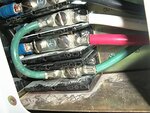RHeTTRoNiCS
Advanced Member level 4
Just a bit confuse...need help from you guys...We have 220AC 3phase line (L1,L2,L3,Ground, & Neutral). But I wanted only to use 110AC to power-up my 110AC power supply. So I tried to measure Neutral and live (either L1, L2, L3) and I can get 110AC. Same goes to Ground and live (either L1,L2,L3).
BUT when I connected the power supply using Ground and live the circuit breaker trips.
When using Neutral and live, the power-supply powered-up fine. When I ohm check neutral and ground can read short.
So why the power supply trip by using ground and live? Why neutral and live is ok?
Ground and Neutral ohm check shorted. Any idea? Thanks.
BUT when I connected the power supply using Ground and live the circuit breaker trips.
When using Neutral and live, the power-supply powered-up fine. When I ohm check neutral and ground can read short.
So why the power supply trip by using ground and live? Why neutral and live is ok?
Ground and Neutral ohm check shorted. Any idea? Thanks.
